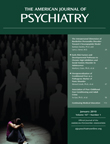Reducing Suicidal Ideation and Depression in Older Primary Care Patients: The Oldest Old and Pain
To the Editor: George S. Alexopoulos, M.D., et al. (1) are to be commended for their article published in the August 2009 issue of the Journal, in which they extended their 2004 Prevention of Suicide in Primary Care Elderly: Collaborative Trial (PROSPECT) study findings to 24-month outcomes for patients ≥60 years of age in the primary care setting. Because the "oldest old," those persons ≥75 years of age, are becoming a more significant portion of the U.S. population (2), it would be interesting to know what percentage of the PROSPECT study these patients comprise and whether the PROSPECT study included nursing home and hospice patients. A limitation of the study, as noted by the authors, was the lack of information on patients' specific medical diagnoses and treatment thereof, which can be important in the assessment of well-being in the oldest old.
Although the toll of chronic diseases becomes apparent in mortality rates with increasing age, the suicide rate for men in the United States is highest among those ≥85 years (3). Beyond defined suicide, the rates of "undetermined deaths" (4) and "voluntary deaths" (e.g., deaths as the result of decreased or no intake of food or water, increased self-administration of drugs, physician-assisted suicide) (5) increase for those older than 75 years of age compared with younger older-age individuals. In addition, the oldest old have a greater tendency to use more determined methods of suicide, such as hanging and firearms (4). Finally, elderly persons with several medical illnesses have an increased risk of suicide. Severe pain, often associated with malignancies, also has a high association with suicide (4).
Besides targeting older men (6), taking into account additional risk factors for suicide might increase treatment efficacy. Patients over 75 years of age, those with access to firearms, and those with multiple medical illnesses and/or severe pain, particularly if they are also men, could be the focus of intervention. Additional efforts beyond depression treatment and reduced access to firearms could include enhanced medical and social support as well as pain management.
1 : Reducing suicidal ideation and depression in older primary care patients: 24-month outcomes of the PROSPECT study. Am J Psychiatry 2009; 166:882–890 Link, Google Scholar
2 Centers for Disease Control and Prevention: Health, United States, 2008. Washington, DC, United States Department of Health and Human Services, 2008 http://www.cdc.gov/nchs/data/hus/hus08.pdf#026 (Accessed August 31, 2009) Google Scholar
3 : Surveillance for violent deaths: National Violent Death Reporting System, 16 States. MMWR Surveill Summ 2009; 58:1–44. http://www.cdc.gov/mmwr/preview/mmwrhtml/ss5801a1.htm#tab3 (Accessed August 31, 2009) Google Scholar
4 : Medical illness, medication use and suicide in seniors: a population-based case-control study. J Epidemiol Community Health 2008; 62:138–146 Crossref, Medline, Google Scholar
5 : Characteristics of patients requesting and receiving physician-assisted death. Arch Intern Med 2003; 163:1537–1642 Crossref, Medline, Google Scholar
6 : Suicide prevention in later life: a glass half full, or half empty? Am J Psychiatry 2009; 166:845–848 Link, Google Scholar



